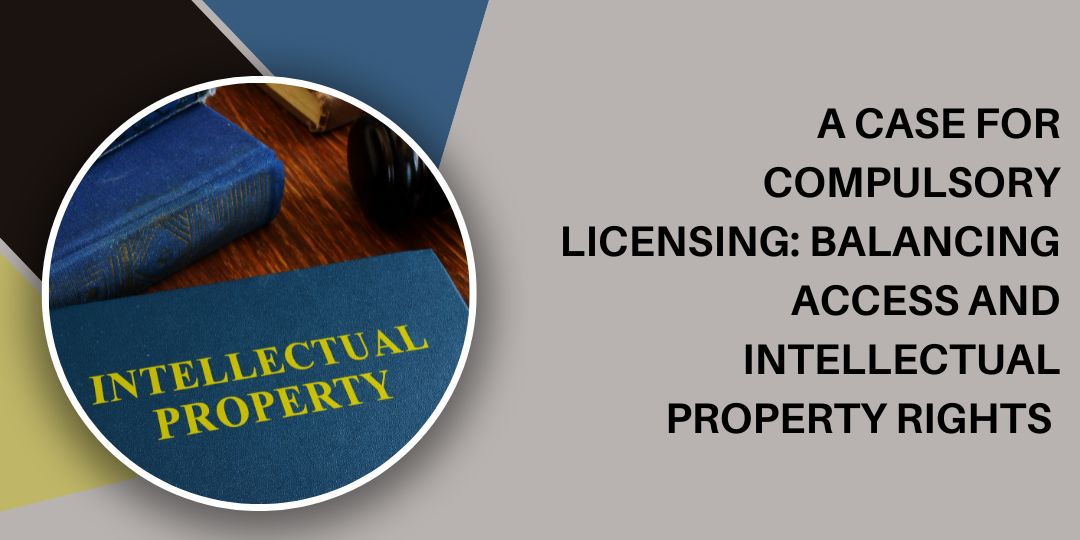A Case for Compulsory Licensing: Balancing Access and Intellectual Property Rights

Sonam Nanda
Advocate, Surana & Surana International Attorneys
INTRODUCTION
The Copyright Act, 1957 plays a pivotal role in safeguarding the rights of creators, authors, producers, performers, and their works. Nevertheless, under certain circumstances, the exclusive rights granted to copyright holders can impede the accessibility of their works to the general public. In order to strike a balance between the protection of intellectual property and the promotion of public interest and rights, Section 31 of the Copyright Act, 1957 was established. Subsequently, several clarifications were introduced to enhance its scope, namely Section 31A, 31B, 31C, and 31D. This article aims to analyse the concept of compulsory licensing and its impact within the framework of the Copyright Act, 1957,and international conventions.
STATUTORY PROVISIONS SUPPORTING COMPULSORY LICENSING
Section 31 of the Copyright Act, 1957 confers the authority for the issuance of compulsory licenses in relation to works that have been duly registered for copyright protection. In the event of a complaint, the Copyright Board or the High Court is empowered to grant a compulsory license to a third party, enabling them to utilize a copyrighted work without obtaining explicit consent from the copyright holder. This permission, however, necessitates the payment of reasonable compensation to the copyright holder. The Copyright Act, 1957 delineates specific prerequisites that must be satisfied for the grant of a compulsory license. These conditions serve to ensure the balanced protection of both the copyright holder’s interests and the public’s interests. To obtain a compulsory license, the petitioner must establish before the Court that the copyright owner: (a) has refused to republish or allow the republication of the work or has refused to allow the performance in public of the work, and by reason of such refusal the work is withheld from the public[1]; or (b) has refused to allow communication to the public by (broadcast) of such work or in the case of a (sound recording) the work recorded in such (sound recording), on terms which the complainant considers reasonable. [2] If the Court finds the reason given by the copyright holder for withholding the copyrightable work from the public to be unreasonable, the Court will direct the Registrar of Copyrights to grant to the complainant a licence to republish the work, perform the work in public or communicate the work to the public by (broadcast), as the case may be, subject to payment to the owner of the copyright a compensation and subject to certain terms and conditions as the Court may determine.
The Berne Convention and the Rome Convention[3] acknowledge the legitimacy of compulsory licensing and provide nations in the union with the autonomy to frame their own regulations and conditions concerning compulsory licenses, as long as they do not prejudice the moral rights of the author or impede the author’s entitlement to fair and reasonable compensation. In the absence of a mutual agreement between the parties involved, the determination of equitable remuneration shall be entrusted to a competent authority. [4]
OBJECTIVE OF COMPULSORY LICENSING
Copyright law grants the copyright holder an exclusive monopoly over their work, but this monopoly can, in certain cases, restrict public rights. To address this concern, compulsory licensing provisions are introduced to mitigate the monopoly and strike a balance between public rights and individual rights which is done by the Copyright Board or the High Court, upon determining the reasonableness of granting a compulsory license. [5]
In the case of Entertainment Network (India) Ltd. v. Super Cassette Industries Ltd., 2008 the Supreme Court elucidated the purpose and essence of Section 31 of the Copyright Act, 1957, highlighting its objective, which was, to benefit the public.[6] The purpose of such a rule is to encourage competition and avoid a situation of monopoly which is rampant in sectors such as the music industry. The aim is to secure access to copyrighted works by the public when copyright owners impose unreasonable conditions for republication. Justice Sinha further emphasized this purpose by stating that “when a right to property creates a monopoly to which the public must have access. Withholding the same from the public may amount to unfair trade practice. In our constitutional scheme of statute monopoly is not encouraged. Knowledge must be allowed to be disseminated. An artistic work if made public should be made available subject of course to reasonable terms and grant of reasonable compensation to the public at large.”[7]
JUDICIAL INTERPRETATION
Section 30 of the Copyright Act, 1957 confers upon the copyright owner the authority to license their work in terms of their choosing. However, Section 31 of the same Act serves the purpose of evaluating the reasonableness of such licensing terms and upholding public rights. In the case of Entertainment Network (India) Ltd. v. Super Cassette Industries Ltd2008, the Supreme Court shed light on the interpretation of the term “public,” determining that “the word ‘public’ must be read to mean the public of all parts of India and not only a particular part.”[8] The Supreme Court further deemed any commercial benefit to the publisher as incidental and ruled that the meaning of “public” should be interpreted broadly. This interpretation enabled the grant of compulsory licenses to emerging radio operators.[9]
The Copyright Board and the High Court holds the power to assess reasonableness when a license is denied by the copyright owner and also possesses the authority to determine the royalty price for a copyrighted work.[10] This ensures that exorbitant prices are not set with the intention of excluding competition and rendering compulsory licenses ineffectual. In the case of Music Broadcast Pvt. Ltd. & Ors. v. Phonographic Performance Ltd, the Respondent declined to grant a license to the Appellant at the suggested royalty rate. It was observed that when new radio operators approached record label companies to get licenses for broadcasting rights, they were met with unreasonably high price royalties. These exorbitant fees proved unfeasible for smaller radio operators to pay, thus impeding their entry into the market. The Copyright Board passed a landmark judgement fixing the royalty rate for broadcast of sound recording on FM radio by providing a revenue-sharing model as 2% of net advertisement earnings of each FM radio station on a pro rata distribution of compensation basis to all music providers.[11] Subsequently, in the case of us Music Broadcast Limited and Ors. vs. Tips Industries Ltd. and Ors.[12]The IPAB fixed the royalty rate for broadcasting sound recordings and for underlying literary and musical works with effect from 1st October 2020 to 30th September 2021.[13]
Recently, in the case of Indian Performing Right Society Ltd. v. Rajasthan Patrika (P) Ltd., 2023[14]The High Court of Bombay deliberated on the issue of whether the Plaintiff, a copyright society who issues licenses on behalf of its composers is also entitled to receive royalty payments from persons like the Defendants who communicate musical works to the public through their FM radio broadcast channels. The Hon’ble Court held the Plaintiff had the right to receive royalties for musical works used as part of sound recordings or in cinematograph films. It was also held that when a composer licenses their work for a cinematographic film, the producer owns the rights of the cinematographic film as a whole and does not hold the rights to the work individually.
CONCLUSION
The concept of compulsory licensing within the framework of the Copyright Act, 1957 and international conventions serves as a mechanism to strike a balance between the rights of copyright holders and the interests of the public. While copyright law grants exclusive monopolies to copyright holders, it is crucial to ensure that these monopolies do not hinder public access to important works. Section 31 of the Copyright Act, 1957 plays a pivotal role in maintaining such a balance. The Courts of the country and the Copyright Board have used this provision to widen the scope of ‘public’ and interfered when copyright owners demand unreasonable terms to give license. Overall, compulsory licensing provisions, along with the oversight of judicial bodies, aim to protect public interests while still respecting the rights of copyright holders. By striking a balance between these two facets, compulsory licensing fosters competition, encourages knowledge dissemination, and ensures that copyrighted works remain accessible to the public at large.
[1] Copyright Act, 1957, Section 31(1)(a).
[2] Copyright Act, 1957, Section 31(1)(b).
[3] International Convention for the Protection of Performers, Producers of Phonograms and Broadcasting Organisations, 1961, Article 15.
[4] Berne Convention for the Protection of Literary and Artistic Works, Sept. 9, 1886, as revised at Paris on July 24, 1971 and amended in 1979, Article 11bis
[5] Section 31(1)(b), The Copyright Act, 1957.
[6] Entertainment Network (India) Ltd. v. Super Cassette Industries Ltd., (2008) 13 SCC 30.
[7] Entertainment Network (India) Ltd. v. Super Cassette Industries Ltd., (2008) 13 SCC 30.
[8] Entertainment Network (India) Ltd. v. Super Cassette Industries Ltd., (2008) 13 SCC 30.
[9] Entertainment Network (India) Ltd. v. Super Cassette Industries Ltd., (2008) 13 SCC 30.
[10] Super Cassettes Industries Ltd. v. Music Broadcast (P) Ltd., (2012) 5 SCC 488.
[11] Music Broadcast Pvt. Ltd. and Ors. vs. Phonographic Performance Ltd. (19.11.2002 – Copyright Board) : MANU/CP/0005/2002.
[12] Music Broadcast Limited and Ors. vs. Tips Industries Ltd. and Ors. (31.12.2020 – IPAB) : MANU/IC/0068/2020.
[13] Copyright Act, 1957, Section 31(D).
[14] Indian Performing Right Society Ltd. v. Rajasthan Patrika (P) Ltd., 2023 SCC OnLine Bom 944.



